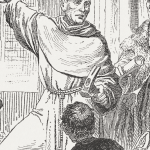Land of the Bible: Temple Mount and more
This video series offers a comprehensive and in-depth exploration of some of the most significant sites in Israel. Join Dr. Varner for an exciting visit to the Temple Mount, the Mount of Olives, the Israel Museum, Hebron, Herodion, and Bethlehem.
Ep. 1 The Temple Mount Part 1
Called in Arabic the "Haram esh Sharif", or the Temple Mount by Jews. Holy to Moslems as the “further mosque” in Mohammed’s “night journey” from where he sanded on Burak to talk with the prophets in heaven. This was also the platform for the Herodian Temple. We stand in the site of the southern Royal Portico where a Corinthian Capital like the one shown was on top of one of the many columns supporting the roof of the portico. On the eastern side was Solomon’s Portico. This was Biblical Mt Moriah (Gen 22) and the site of Araunah the Jebusite’s threshing floor (2 Sam 24).
In front of the El Aksa Mosque in the southern section, constructed in about 710 AD. The Crusaders turned the mosque into the Temple of Solomon, headquarters of the Templars. The Dome was called the Temple of the Lord.
The video is located in the Court of the Gentiles and near where two tunnels came up from the gates on the southern wall.
In front of the El Aksa Mosque in the southern section, constructed in about 710 AD. The Crusaders turned the mosque into the Temple of Solomon, headquarters of the Templars. The Dome was called the Temple of the Lord.
The video is located in the Court of the Gentiles and near where two tunnels came up from the gates on the southern wall.
Ep. 2 The Temple Mount Part 2
The "Kubat Es Saqra" (Dome of the Rock) is where Abraham offered Isaac, but Moslems believe he was Isaac (in Mecca). Here there is reflection on Genesis 22 and the Akedah (Binding) of Isaac. In this video we stand on the first level, the Court of the Gentiles, facing where a low fence separated from the court of the Jews on a bit higher level.
The octagonal Dome of the Rock (690 AD) built by Abd al Malik, one of the most beautiful buildings in the world, faced with mosaics and with a golden dome furnished by King Hussein. The hole in the rock beneath the dome was part of the threshing floor.
Dr. Varner is standing on the site of the Beautiful Gate (Acts 3) where worshippers would leave the Outer court to enter the Court of the Women. Here Peter healed the lame man who was asking for alms. Two terms are translated “temple.” One was the hieron (the temple enclosure) and the naos (the temple proper).
The octagonal Dome of the Rock (690 AD) built by Abd al Malik, one of the most beautiful buildings in the world, faced with mosaics and with a golden dome furnished by King Hussein. The hole in the rock beneath the dome was part of the threshing floor.
Dr. Varner is standing on the site of the Beautiful Gate (Acts 3) where worshippers would leave the Outer court to enter the Court of the Women. Here Peter healed the lame man who was asking for alms. Two terms are translated “temple.” One was the hieron (the temple enclosure) and the naos (the temple proper).
Ep. 3 The Temple Mount Part 3
In the southeastern corner of the mount, there is now an underground mosque in the area known as Solomon’s Stables. The “stables” were actually a series of arches to support the extended platform above. The area was entered through the triple gate on the southern wall.
The video is located inside the Eastern Gate. A gate is more than an opening in the wall but a large structure with vestibules and rooms. Although opened at times, it has been finally closed since the late Middle Ages. It is blocked to prevent any Jewish or Christian Messiah from entering. Reflections on the “ascent” Psalms and the glory departing in Ezek 9-11 and returning in Ezek 43.
The next section is at a small cupola called the Dome of the Tablets, one suggested site of the Holy of Holies, according to Asher Kaufman. Although attractive, no major archaeologists hold to his view, but still prefer the rock under the Dome as the Holy of Holies. Leen Rittmeyer has argued effectively for the Dome as the genuine site.
The next site consists of stones that go back to the Herodian and possibly the Hasmonean/Maccabean times.
Finally there is a view toward the northwestern corner of the mount where stood the Antonia Fortress. Herod cut away the rock to accommodate the corner of the Temple. The rock ledge on which the fortress stood can be seen. Here recall the riot and arrest of Paul (Acts 21) and his address to the Jew from the staircase of the fortress (Acts 22).
The video is located inside the Eastern Gate. A gate is more than an opening in the wall but a large structure with vestibules and rooms. Although opened at times, it has been finally closed since the late Middle Ages. It is blocked to prevent any Jewish or Christian Messiah from entering. Reflections on the “ascent” Psalms and the glory departing in Ezek 9-11 and returning in Ezek 43.
The next section is at a small cupola called the Dome of the Tablets, one suggested site of the Holy of Holies, according to Asher Kaufman. Although attractive, no major archaeologists hold to his view, but still prefer the rock under the Dome as the Holy of Holies. Leen Rittmeyer has argued effectively for the Dome as the genuine site.
The next site consists of stones that go back to the Herodian and possibly the Hasmonean/Maccabean times.
Finally there is a view toward the northwestern corner of the mount where stood the Antonia Fortress. Herod cut away the rock to accommodate the corner of the Temple. The rock ledge on which the fortress stood can be seen. Here recall the riot and arrest of Paul (Acts 21) and his address to the Jew from the staircase of the fortress (Acts 22).
Ep. 4 Mount of Olives Part 1
This video is against the backdrop of the panoramic view of Jerusalem from near the summit of the Mt of Olives. The role of the mountain is traced from the flight of David from Absalom (2 Sam 14-16) through the prophetic promises of Messiah returning to the Mt of Olives (Zach 14).
The Mount of Olives is also the site of the “Triumphal Entry” of Jesus at the beginning of Passion Week.
The Mount of Olives is also the site of the “Triumphal Entry” of Jesus at the beginning of Passion Week.
Ep. 5 Mount of Olives Part 2
This video is an explanation of modern Jewish burial practices in the midst of tombs on the mount.
At the church Dominus Flevit (“the Lord wept”) down the slope of the mount we examine a Second Temple burial cave filled with ossuaries and discuss ancient Jewish burial practices.
The Church of All Nations contains a large number of olive trees near Gethsemane. There is also a clear view of the blocked Eastern Gate.
The alley of a grotto of Gethsemane, meaning “olive press,” is one of the most reliable sites associated with Jesus. The cave reveals evidence of its use for olive oil production. Here Jesus gathered with his disciples on a number of nights before and during Passion Week.
At the church Dominus Flevit (“the Lord wept”) down the slope of the mount we examine a Second Temple burial cave filled with ossuaries and discuss ancient Jewish burial practices.
The Church of All Nations contains a large number of olive trees near Gethsemane. There is also a clear view of the blocked Eastern Gate.
The alley of a grotto of Gethsemane, meaning “olive press,” is one of the most reliable sites associated with Jesus. The cave reveals evidence of its use for olive oil production. Here Jesus gathered with his disciples on a number of nights before and during Passion Week.
Ep. 6 2nd Temple Model of Jerusalem Part 1
These videos consist of a tour of the model of Jerusalem at the Israel Museum. The model was originally at the Holy Land Hotel but was moved here in the last decade. It is based both on Josephus’ description and archaeological excavations. It contains a few speculations, like the location of the theater and the hippodrome as well as the portrayal of the area between the second and third walls to the north.
Ep. 7 2nd Temple Model of Jerusalem Part 2
In addition to the features, take note of how we can trace the path of Jesus during the final week, especially his three Jewish “trials” (Annas, Caiaphas, Sanhedrin) and his three Roman “trials” (Pilate, Herod Antipas, Pilate). The actual “Via Dolorosa” led from the palace area south of the ancient gate today called the Jaffa Gate to outside the “garden gate” to Golgotha.
The three towers were called Phasael, Hippicus, and Mariamne. The base of the Tower Phasael is where the Museum of the History of Jerusalem is located today.
The three towers were called Phasael, Hippicus, and Mariamne. The base of the Tower Phasael is where the Museum of the History of Jerusalem is located today.
Ep. 8 2nd Temple Model of Jerusalem Part 3
The view of Jerusalem as it was in the first century AD from the east on the Mt of Olives. Note the various features of the Herodian Temple and the events in the Gospels and Acts that took place there. Note also the Pools of Bethesda.
Ep. 9 Shrine of the Book
On the outside of the Shrine of the Book is a large white structure that calls to mind the cap of the jar in which the first 7 scrolls were found (Cave One). The black obelisk counters the white cap and recalls the title of one of those original scrolls, “The War of the Sons of Light with the Sons of Darkness.” In addition to the first even, a total of 850 scrolls have been discovered although the vast majority in scraps, mostly found in Cave Four. Over 500 are Biblical scrolls and the rest are sectarian documents related to the life of the Essenes, the community at Qumran that copied the scrolls.
Ep. 10 Western Wall Tunnel Part 1
Western Wall Tunnel Part 1 and 2 consist of a guided tour of the tunnels by one of their local Jewish guides. Compare the explanation with that mentioned above in The Holy Land.
Ep. 11 Western Wall Tunnel Part 2
This video is Part 2 of a guided tour of the Western Wall Tunnel by a local Jewish guide.
Ep. 12 Hebron Part 1
Hebron is the site of the cave of Machpela, which Abraham bought as a grace site for Sarah (Gen 24). The three Patriarchs (Abraham, Isaac, Jacob) are buried there with their wives (Sarah, Rebekah, Leah). The structure built over the Cave is definitely Herodian from its architecture with the large ashlars and engaged pilasters. The exterior walls appear much like the walls of the retaining wall around the Temple mount would have appeared.
Ep. 13 Hebron Part 2
The steps up to the Moslem side of the Haram el Khalil (the sanctuary of the Friend) are notable because Jews could only go up to the seventh step. The Moslem side of the Haram includes the minbar (pulpit), the mihrab (prayer niche) toward Mecca and the tombs of Isaac and Rebekah. Both Jewish and Moslem sides share access to the tombs of Abraham and Sarah.
The last brief section is in the Jewish side where we witness a Talmudic study session in the Jewish yeshiva.
The last brief section is in the Jewish side where we witness a Talmudic study session in the Jewish yeshiva.
Ep. 14 Hebron Part 3
This video continues our visit to the Jewish side of the site which has been turned into a yeshiva by the Jewish settlers living near here since 1967. It includes the tombs of Jacob and Leah and shares the tombs of Abraham and Sarah.
Ep. 15 Hebron Part 4
This video continues our visit to the Jewish side of the site which includes the tombs of Jacob and Leah, and includes a conversation with a religious man about Jewish culture, religion, and their view of Messiah.
Ep. 16 Herodion Part 1
Herodion was one of three desert fortresses built by Herod the Great (Masada and Machaerus the other two). He built it to commemorate one of his victories over the Parthians as he was establishing his control. He also requested to be buried here. His body was carried here after his death in Jericho, 4 BC. Water was brought from the pools near Bethlehem by aqueduct.
Herod may have sent a detachment of soldiers from Herodion to kill the young Messiah just a couple of miles away in Bethlehem. The spiritual application is that the King by might (Herod) is gone with no followers. The King by right (Jesus) lives with a billion followers.
Herod may have sent a detachment of soldiers from Herodion to kill the young Messiah just a couple of miles away in Bethlehem. The spiritual application is that the King by might (Herod) is gone with no followers. The King by right (Jesus) lives with a billion followers.
Ep. 17 Herodion Part 2
In this video, we explore the rooms inside the “cone” of the fortress with its bath house, living quarters, and its synagogue for the later Zealots.
The tunnel system through the cisterns was used by the Zealots from 66-70 AD and the Bar Cochba fighters (132-135 AD).
We conclude our visit with a view of the burial area. Tragically, Ehud Netzer had recently died as a result of a fall at Herodion.
The tunnel system through the cisterns was used by the Zealots from 66-70 AD and the Bar Cochba fighters (132-135 AD).
We conclude our visit with a view of the burial area. Tragically, Ehud Netzer had recently died as a result of a fall at Herodion.
Ep. 18 Bethlehem Part 1
In the video, we can see the Church of the Nativity that was built by Justinian in the 6th century, still standing in its original form. The doorway of the church has undergone several modifications over the years due to various historical events. Originally, it had a huge doorway which was later filled in with smaller doors during the Crusader and Turkish periods. The Crusader door is noticeable by its pointed arch, and the Turkish period door is small in size, designed to prevent Moslem horse riders from entering.
Onside we examine the nave and two side isles (Basilica construction) and see the mosaic floor from the earlier 4th century Constantinian church.
Onside we examine the nave and two side isles (Basilica construction) and see the mosaic floor from the earlier 4th century Constantinian church.
Ep. 19 Bethlehem Part 2
We step into a grotto that Justin Martyr claimed to be the exact location of Jesus' birth in the mid-2nd century. This cave is a section of a larger cave system that has been sealed off between the Greek Orthodox Church - our current location, and the Roman Catholic Church, which we will be visiting next.
After exiting from one church, we move towards another and venture down into the continuation of the cave. This is the very spot where Jerome acquired his knowledge of Hebrew and subsequently translated the Old Testament into Latin, which became a part of the Vulgate, around 400 AD. Our visit concludes with a glimpse of the statue of Jerome in the courtyard. We also learn about the traditions associated with him such as the skull and the lion. Additionally, we delve into his conflict with Augustine over the wisdom of translating from the Hebrew instead of the Greek LXX.
After exiting from one church, we move towards another and venture down into the continuation of the cave. This is the very spot where Jerome acquired his knowledge of Hebrew and subsequently translated the Old Testament into Latin, which became a part of the Vulgate, around 400 AD. Our visit concludes with a glimpse of the statue of Jerome in the courtyard. We also learn about the traditions associated with him such as the skull and the lion. Additionally, we delve into his conflict with Augustine over the wisdom of translating from the Hebrew instead of the Greek LXX.



